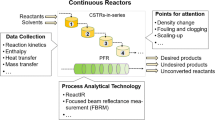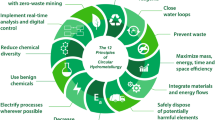Abstract
Shortening the time required for chemical process development from the first laboratory trial through technical and pilot plants to industrial installation is a long-standing aim. Knowledge of the reaction kinetics is of major importance for this purpose. The usefulness of thermokinetics in chemical process engineering is illustrated by reaction of phenyl isocyanate andn-butanol.
Zusammenfassung
Die Abkürzung der Verfahrensentwicklung vom ersten Laborversuch über Technikums- und Pilotanlagen bis zur großtechnischen Anlage ist ein seit langem erstrebtes Ziel. Dabei ist bekanntlich die Kenntnis der Reaktionskinetik von großer Bedeutung. Am Beispiel der Reaktion Phenylisocyanat undn-Butanol wird die Nützlichkeit der Thermokinetik in der chemischen Verfahrensentwicklung aufgezeigt.
Резюме
Сокращение времени, т ребуемого для протек ания химического процесс а, начиная от первоначальных лабо раторных испытаний н а опытных и пилотных установках до промышленных установок, является д авнишней мечтой. Для д остижения этой цели главным явл яется знание кинетики реакций. Пол езность термокинети ки в химической технолог ии показана на пример е реакции фенилизоциа ната с н-бутанолом.
Similar content being viewed by others
Abbreviations
- A :
-
characterizing alcohol
- a :
-
concentration of alcohol
- c i :
-
concentration of chemical speciesi
- E :
-
activation energy
- f(ci, pi):
-
functionality of the rate equation on concentration and partial pressure of species
- F :
-
heat exchange area
- I :
-
characterizing isocyanate
- i :
-
concentration of isocyanate
- ΔH :
-
reaction enthalpy
- k :
-
heat exchange coefficient
- K 1,K 2,K 1,K 2 :
-
rate constants
- L 1,L 2 :
-
heating powers of intermediate thermostat and reactor
- L R1 L R2 :
-
stirring powers of intermediate thermostat and reactor
- L M2 :
-
power of reactor motor
- o :
-
index characterizing facts at start of reaction
- P i :
-
partial pressure of chemical speciesi
- q j :
-
thermal reaction power of elementary reactionj
- q :
-
total reaction power
- q :
-
auxiliary quantity
- Q(t) :
-
heat of reaction evolved up to timet
- Q 00 :
-
total heat of reaction
- r :
-
reaction rate
- T s :
-
temperature of base thermostat
- ΔT 1s :
-
set temperature difference intermediate/base thermostat
- ΔT 2s :
-
set temperature difference reactor/intermediate thermostat
- t :
-
time as from start of reaction
- U :
-
characterizing urethane
- u :
-
concentration of urethane
- V :
-
volume of reaction mix
- ΔV A :
-
volume of injected alcohol
- α :
-
auxiliary rate factor
- β :
-
auxiliary rate factor
- v :
-
characterizing individual measurement
References
K. C. Frisch, S. L. Rugan: Advances in Urethanes, 1962, Interscience Publ., New York.
W. Litz, J. Thermal Anal., 27 (1983) 215.
Author information
Authors and Affiliations
Rights and permissions
About this article
Cite this article
Litz, W. Application of thermokinetics in chemical process analysis, as illustrated by the reaction of phenyl isocyanate andn-Butanol. Journal of Thermal Analysis 30, 627–640 (1985). https://doi.org/10.1007/BF01913609
Received:
Issue Date:
DOI: https://doi.org/10.1007/BF01913609




